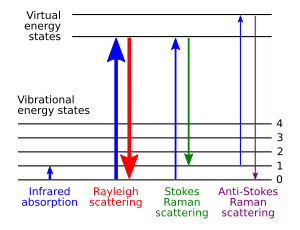Light scattering from laser probes (fiber optics) are being developed as diagnostic tools to differentiate between healthy and diseased cells.  These tools would be a (safer) replacement for the ubiquitous x-ray machines that have been used; moreover, the device provides more accurate information at a lower cost.  Preliminary results for a variety of diseases were presented at this year’s International Conference on Raman Spectroscopy (ICORS).
Raman Spectroscopy (RS) measures the changes in wavelength and intensity from the laser probe, after it becomes scattered from the target. The positive attribute of RS is that sample preparation is not required (nor is it an invasive technique); the negative aspect is that RS is not particularly sensitive. However, RS can detect changes in cell composition, due to illness or cancer, as compared to their healthy state; those changes alter the spectrum results.
Researchers at the University of Michigan (under the direction of Dr. Michael Morris) found that RS is particularly effective for bone analysis (osteoporosis); the minerals within the bone provide clearly distinguishable Raman bands, which differ according to age, diet, degree of loading and exercise, as well as disease. RS is capable of predicting susceptibility to fracture and the effectiveness of a therapeutic regimen. Currently, X-ray systems are used to predict therapeutic outcomes with moderate success; RS would greatly surpass this as a predictor.
Research groups from Rutherford Appleton Laboratory and Gloucestershire Royal Hospital (both in the UK) have employed RS to determine breast tissue calcification. As is true for bone, the calcifications are primarily deposits of hydroxyapatite. The calcifications are what is observed in positive mammograms. Other research groups in Singapore and at Vanderbilt University are examining the use of RS for stomach and cervical cancers (as opposed to Pap smears), respectively).
Tooth decay (dental caries) was the target for  Dr. Choo-Smith at Canada’s National Research Council (Winnipeg) research. As with bone, the primary component of teeth is hydroxyapatite, which has that strong Raman band. Tooth decay involves the acid leaching (by Streptococcus mutans and others) of the minerals. Very small decay pits (100 to 250 μm) can be detected; in these cases sealants or antimicrobial treatments would be viable as opposed to drill and fill techniques that we commonly employ now. The researchers hope to begin work with live subjects very shortly.








Thanks a lot. It was cool seeing
Ferry pour la Grece I am so glad you found my blog- and enjoy reading it. That’s why I write. Thanks, RAAckerman
Thanks a lot. This is fun hearing
good news, but the first symptom of caries nevertheless is a dental pain
Kelly recently posted..How to Remove Gaps Between Teeth
I am not sure that is true, Kelly! There are plenty of instances of dental caries with not a drop of associated pain. But, generally, that could be true.
Thanks for your comments.
Roy
Hello there, simply was aware of your weblog via Google, and located that it’s really informative. I am going to be careful for brussels. I’ll appreciate if you continue this in future. A lot of people might be benefited from your writing. Cheers!
Ana recently posted..back pain issues